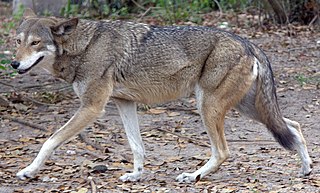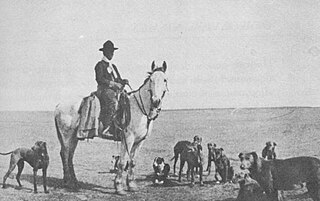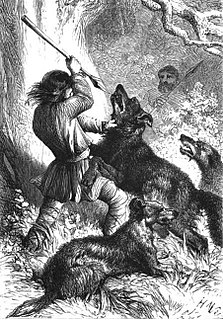
The coyote is a species of canine native to North America. It is smaller than its close relative, the wolf, and slightly smaller than the closely related eastern wolf and red wolf. It fills much of the same ecological niche as the golden jackal does in Eurasia. The coyote is larger and more predatory and was once referred to as the American jackal by a behavioral ecologist. Other historical names for the species include the prairie wolf and the brush wolf.

The red wolf is a canine native to the southeastern United States. Its size is intermediate between the coyote and gray wolf.

The wolf, also known as the gray wolf or grey wolf, is a large canine native to Eurasia and North America. More than thirty subspecies of Canis lupus have been recognized, and gray wolves, as popularly understood, comprise non-domestic/feral subspecies. The wolf is the largest extant member of the family Canidae. It is also distinguished from other Canis species by its less pointed ears and muzzle, as well as a shorter torso and a longer tail. The wolf is nonetheless related closely enough to smaller Canis species, such as the coyote and the golden jackal, to produce fertile hybrids with them. The banded fur of a wolf is usually mottled white, brown, gray, and black, although subspecies in the arctic region may be nearly all white.

The Eastern Wolf also known as the Timber Wolf, Algonquin wolf or Eastern timber wolf, is a canine of debated taxonomy native to the Great Lakes region and southeastern Canada. It is considered to be either a unique subspecies of gray wolf or a separate species from the gray wolf. Many studies have found the eastern wolf to be the product of ancient and recent genetic admixture between the gray wolf and the coyote, while other studies have found some or all populations of the eastern wolf, as well as coyotes, originally separated from a common ancestor with the wolf over 1 million years ago and that these populations of the eastern wolf may be the same species as or a closely related species to the red wolf of the Southeastern United States. Regardless of its status, it is regarded as unique and therefore worthy of conservation with Canada citing the population in eastern Canada as being the eastern wolf population subject to protection.

The black-backed jackal is a medium-sized canine native to eastern and southern Africa. These regions are separated by roughly 900 kilometers.

The Hokkaido wolf, also known as the Ezo wolf and in Russia as the Sakhalin wolf, is an extinct subspecies of gray wolf that once inhabited coastal north-east Asia. Its nearest relatives were the wolves of North America rather than Asia. It was exterminated in Hokkaido during the Meiji Restoration period, when American-style agricultural reforms incorporated the use of strychnine-laced baits to kill livestock predators. Some taxonomists believe that it survived up until 1945 on the island of Sakhalin. It was one of two subspecies that were once found in the Japanese archipelago, the other being the Japanese wolf.

Wolf hunting is the practice of hunting gray wolves (Canis lupus) or other species of wolves. Wolves are mainly hunted for sport, for their skins, to protect livestock and, in some rare cases, to protect humans. Wolves have been actively hunted since 8,000 to 10,000 years ago, when they first began to pose a threat to livestock vital for the survival of Neolithic human communities. Historically, the hunting of wolves was a huge capital- and manpower-intensive operation. The threat wolves posed to both livestock and people was considered significant enough to warrant the conscription of whole villages under threat of punishment, despite the disruption of economic activities and reduced taxes. The hunting of gray wolves, while originally actively endorsed in many countries, has become a controversial issue in some nations. Opponents see it as cruel, unnecessary and based on misconceptions, while proponents argue that it is vital for the conservation of game herds and as pest control.

The Mexican wolf, also known as the lobo, is a subspecies of gray wolf native to southeastern Arizona and southern New Mexico in the United States, and northern Mexico; it also previously ranged into western Texas. It is the smallest of North America's gray wolves, and is similar to the extinct Great Plains wolf, though it is distinguished by its smaller, narrower skull and its darker pelt, which is yellowish-gray and heavily clouded with black over the back and tail. Its ancestors were likely the first gray wolves to enter North America after the extinction of the Beringian wolf, as indicated by its southern range and basal physical and genetic characteristics.

The Great Plains wolf, also known as the buffalo wolf or loafer, is an extinct subspecies of gray wolf that once extended throughout the Great Plains, from southern Manitoba and Saskatchewan in Canada southward to northern Texas in the United States. The subspecies was declared extinct in 1926. They were described as a large, light-colored wolf but with black and white varying between individual wolves, with some all white or all black. The Native Americans of North Dakota told of how only three Great Plains wolves could bring down any sized bison.
Wolf reintroduction involves the reintroduction of a portion of grey wolves in areas where native wolves have been extirpated. More than 30 subspecies of Canis lupus have been recognized, and grey wolves, as colloquially understood, comprise nondomestic/feral subspecies. Reintroduction is only considered where large tracts of suitable wilderness still exist and where certain prey species are abundant enough to support a predetermined wolf population. Latest reintroduction has been successful in the Northeast of Scotland, just outside the town of Huntly.

The Legend of Lobo is a 1962 American animal-adventure film that follows the life and adventures of Lobo, a wolf born and raised in southwestern North America. Based upon "Lobo the King of Currumpaw" by Ernest Thompson Seton from the author's 1898 book titled Wild Animals I Have Known, neither the time period nor the precise location are specified in the film; in part because the story is told as much from a wolf's point of view as from a human's. There is no dialogue in the film, with the only interpretation presented through the use of story-song composed and sung by the Sons of the Pioneers and the Sherman Brothers, and narration by Rex Allen. Based on the non-fiction account by Seton, Lobo is an 1890s wolf from an account by Seton who was a naturalist, and was a bounty hunter in the real-life story. Filming took place in Sedona, Arizona.

Wolfers was a term used to refer to both professional and civilian wolf hunters who operated in North America in the 19th and early 20th centuries.

The Wolves of Ashta were a pack of 6 man-eating Indian wolves which between the last quarter of 1985 to January 1986, killed 17 children in Ashta, Madhya Pradesh, a town in the Sehore district. The pack consisted of two adult males, one adult female, one subadult female and two pups. Initially thought to be a lone animal, the fear caused by the wolves had serious repercussions on the life of the villagers within their hunting range. Farmers became too frightened to leave their huts, leaving crops out of cultivation, and several parents prohibited their children from attending school, for fear that the man-eaters would catch them on the way. So great was their fear, that some village elders doubted the man-eaters were truly wolves at all, but Shaitans. With the exception of the pups, which were adopted by Pardhi tribesmen, all wolves were killed by hunters and forest officials.

Wolf hunting with dogs is a method of wolf hunting which relies on the use of hunting dogs. While any dog, especially a hound used for hunting wolves may be loosely termed a "wolfhound", several dog breeds have been specifically bred for the purpose, some of which, such as the Irish Wolfhound, have the word in their breed name.

Wolf: The Journey Home, originally titled Hungry for Home: A Wolf Odyssey, is a 1997 American young adult novel written by 'Asta Bowen. Originally published by Simon & Schuster with line drawings by Jane Hart Meyer, it was retitled and reprinted without illustrations in 2006 by Bloomsbury Publishing. Based on true accounts of the Pleasant Valley, Montana, wolf pack, the novel traces the life of a female alpha wolf named Marta after the forced relocation of her pack in 1989 to an unfamiliar territory. Terrified, Marta abandons her pack and begins a journey in search of her home; she eventually arrives in Ninemile Valley, where she finds a new mate with whom she starts a new pack.

The History of wolves in Yellowstone included extirpation, absence and reintroduction of the gray wolf to Yellowstone National Park. The reintroduction of wolves was controversial as it is with the worldwide reintroduction of wolves. When Yellowstone National Park was created in 1872, wolf populations were already in decline in Montana, Wyoming and Idaho. The creation of the national park did not provide protection for wolves or other predators, and government predator control programs in the first decades of the 1900s essentially helped eliminate the gray wolf from Yellowstone. The last wolves were killed in Yellowstone in 1926. After that, sporadic reports of wolves still occurred, but scientists confirmed that sustainable wolf populations had been extirpated and were absent from Yellowstone during the mid-1900s.

OR-7, also known as Journey, was a male gray wolf that was electronically tracked as he migrated from the Wallowa Mountains in the northeastern corner of the U.S. state of Oregon to the southern Cascade Range. After the wolf dispersed from his natal pack in 2011, he wandered generally southwest for more than 1,000 miles (1,600 km) through Oregon and northern California. He was the first confirmed wild wolf in western Oregon since 1947 and the first in California since 1924.
The repopulation of wolves in Colorado resulted from the natural expansion of the gray wolf into habitats in Colorado they occupied prior to the wolf's near extirpated from the conterminous United States. In the 1940s, the species was nearly eradicated from the Southern Rockies. Wolves were reintroduced in the northern Rocky Mountains in the 1990s and since at least 2014, solitary wolves have entered Colorado. A resident group in northwestern Colorado was confirmed in early 2020. In June 2021, Colorado Parks and Wildlife reported that the first litter of wolf pups had been born in the state since the 1940s. With a November 2020 ballot measure, voters approved reintroducing wolves by the end of 2023.
The repopulation of wolves in Midwestern United States has occurred naturally as the gray wolf has expanded its territory after being nearly extirpated from the conterminous United States. The Midwestern states of Michigan, Minnesota, and Wisconsin are estimated to have 4,400 wolves. The western Great Lakes region they inhabit includes the forested areas of these states, along with the Canadian provinces of Manitoba and Ontario. In 1978, wolves were protected under the federal Endangered Species Act as it was determined that they were in danger of going extinct and needed protection to aid their recovery. Management under the Act allowed the remaining wolves in Minnesota to flourish and repopulate northern Wisconsin and the Upper Peninsula of Michigan. Wolves were removed from federal protection in January 2021 with management authority remaining with state and tribal authorities. Management plans guide each state's decisions about wolf regulations for hunting, trapping, and culling along with population monitoring, and livestock damage control.
















